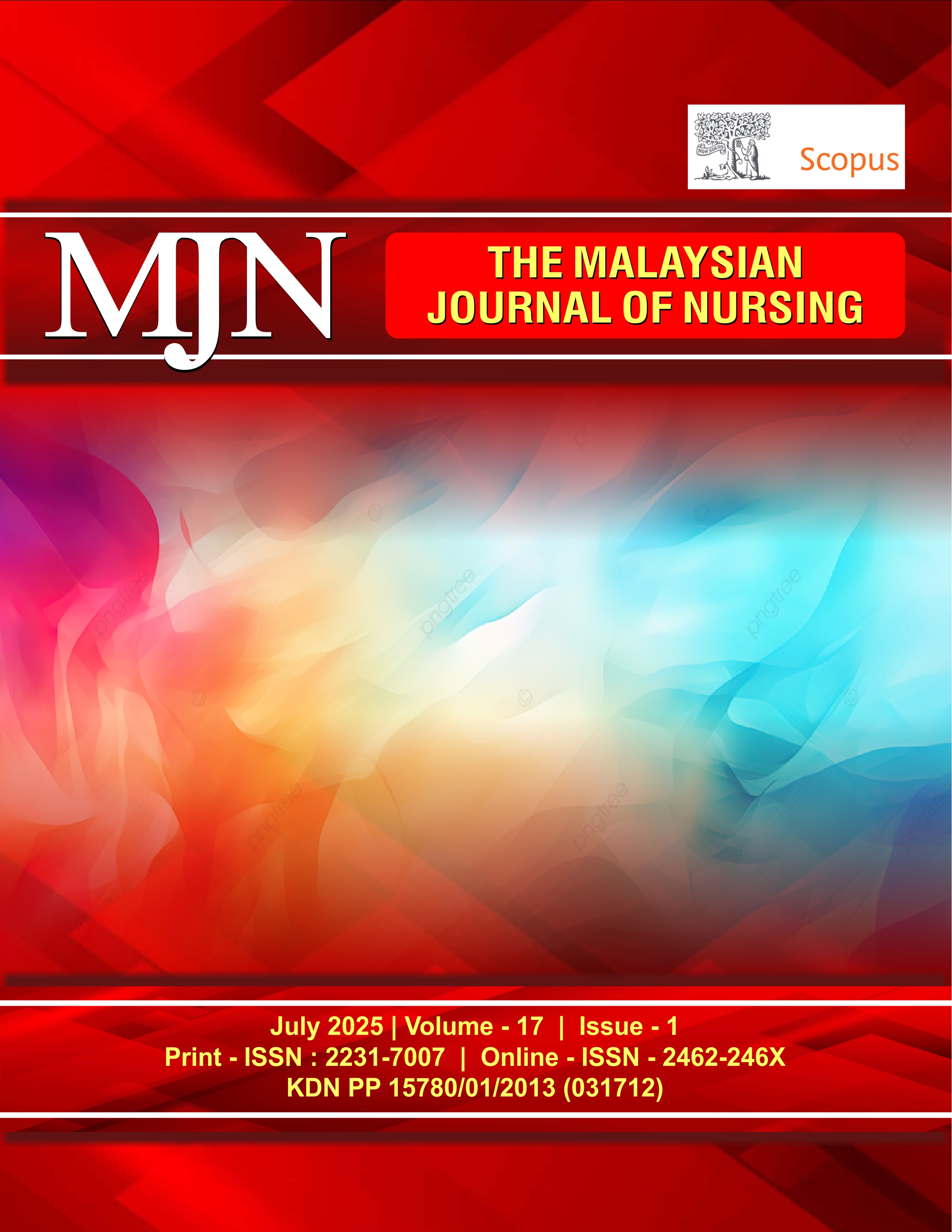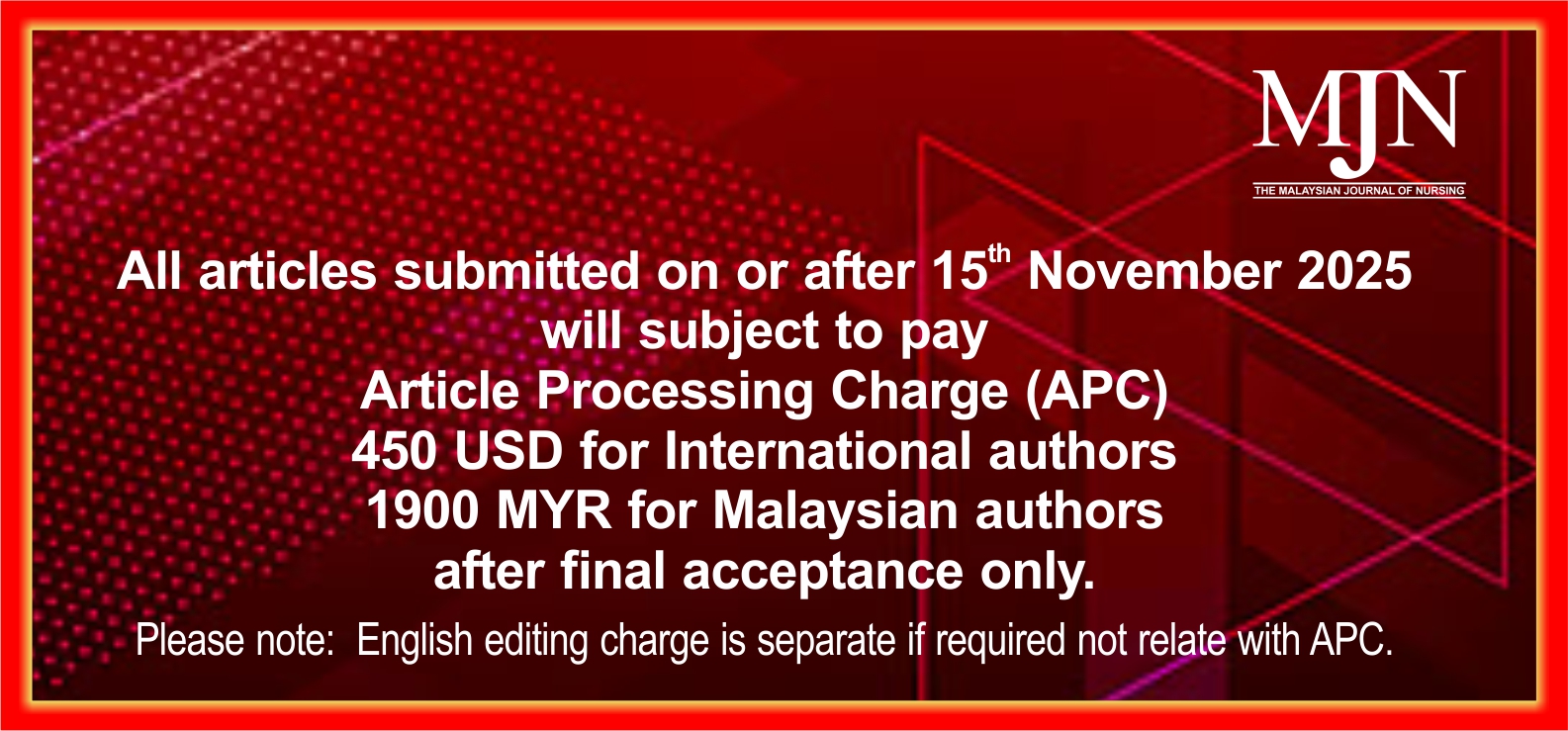Effectiveness of Distraction Cards in Reducing Pain During Peripheral Intravenous Cannulation in School-Age Children: A Randomised Controlled Trial
DOI:
https://doi.org/10.31674/mjn.2025.v17i01.002Abstract
Background: Following ethical and legal professional obligations, nurses should use evidence-based methods to enhance the patient experience during intravenous cannulation. Non-pharmacological pain management techniques are now used in the clinical setting and can be performed without additional cost or time. Therefore, this study targets alleviating pain during intravenous cannulation procedures. Objectives: To investigate the effects of distraction cards in reducing peripheral intravenous cannulation-related pain among school age children. Methods: A comparative and prospective randomised controlled trial was employed. The study was carried out on 148 school-age children who had Peripheral Intravenous Cannulation (PIVC). Patients were divided into two groups randomly: the Distraction Cards group (n = 71) and the control group (n = 77). Immediately after the PIVC procedure, the patients were asked to rate their level of pain by using the Wong-Baker Faces Pain Scale. Results: Pain intensity was significantly lower in the Distraction Cards group compared to the control group (p < 0.001), with a mean difference of 2.27. Conversely, the control group exhibited moderately higher pain scores (mean difference = 3.23) relative to the Distraction Cards group. Conclusion: Distraction cards are effective in relieving pain during IV cannulation. Similar experimental studies in larger children community samples are recommended to provide stronger evidence of their effectiveness.
Keywords:
Distraction Cards, Intravenous Cannulation, Pain ManagementDownloads
References
Abdul-Hussein, H. N., & Hattab, W. A. A. (2022). Pain management for patients with acute myocardial infraction: An interventional study for nursing staff. Pakistan Journal of Medical & Health Sciences, 16(03), 889-889. https://doi.org/10.53350/pjmhs22163889
Al-Musawi, K. M., Aldoori, N., Ajil, Z. W., Qasem, R., Ali, H., & Ammar, S. (2020). Daily living activities of school age children with acute lymphocytic leukemia at welfare pediatric teaching hospital. Indian Journal of Forensic Medicine & Toxicology, 14(3), 1411-1417. Retrieved from: https://shorturl.at/616gb. Accessed on 28th July 2023.
AL-Shammiry, S. E., & AL-Fayyadh, S. (2024). Manual pressure verses shot blocker in reducing intramuscular injection related pain: A comparative randomized controlled trial. Bahrain Medical Bulletin, 46(1). Retrieved from: https://www.bahrainmedicalbulletin.com/March_2024/BMB-23-512.pdf. Accessed on 14th June 2023.
Asefi Rad, A., & Wippert, P. M. (2024). Insights into pain distraction and the impact of pain catastrophizing on pain perception during different types of distraction tasks. Frontiers in Pain Research, 5. https://doi.org/10.3389/fpain.2024.1266974.
Balliel, N. (2023). Effect of soap bubbles technique, coughing and distraction cards on reducing pain and anxiety during phlebotomy in children. Paediatric and Neonatal Pain, 5(2), 31-37. https://doi.org/10.1002/pne2.12090
Besirik, S. A., & Sahiner, N. C. (2024). Comparison of the effectiveness of three different distraction methods in reducing pain and anxiety during blood drawing in children: A randomized controlled study. Journal of Pediatric Nursing, 79, 225-233. https://doi.org/10.1016/j.pedn.2024.09.009
Erdogan, B., & Ozdemir, A. A. (2021). The effect of three different methods on venipuncture pain and anxiety in children: distraction cards, virtual reality, and Buzzy®(randomized controlled trial). Journal of Pediatric Nursing, 58, e54-e62. https://doi.org/10.1016/j.pedn.2021.01.001
Fadhil, S. N., & Ali, R. M. (2019). Effect of Non-pharmacological pain Management Methods on Reduction the Severity of Labor Pain in Primigravida Women at AL-Elwyia Maternity Teaching Hospital. Indian Journal of Public Health Research & Development, 10(7). http://dx.doi.org/10.5958/0976-5506.2019.01653.X
Garra, G., Singer, A. J., Domingo, A., & Thode, H. C., Jr (2013). The Wong-Baker pain FACES scale measures pain, not fear. Pediatric emergency care, 29(1), 17–20. https://doi.org/10.1097/PEC.0b013e31827b2299
Gerards, M., Miller, J., Doshi, D., Hoyer, A., Flöttmann, N., & Barthlen, W. (2025). Virtual reality for distraction during painful procedures in pediatric surgery: A randomized clinical trial. Journal of Pediatric Nursing, 82, 116-122. https://doi.org/10.1016/j.pedn.2025.03.001
Hao, H., Ramli, R., Wang, C., Liu, C., Shah, S., Mullen, P., ... & Du, X. (2023). Dorsal root ganglia control nociceptive input to the central nervous system. PLoS Biology, 21(1). https://doi.org/10.1371/journal.pbio.3001958
İnangil, D., Şendir, M., & Büyükyılmaz, F. (2020). Efficacy of cartoon viewing devices during phlebotomy in children: a randomized controlled trial. Journal of PeriAnesthesia Nursing, 35(4), 407-412. https://doi.org/10.1016/j.jopan.2020.01.008.
Indarwati, F., Munday, J., & Keogh, S. (2022). Nurse knowledge and confidence on peripheral intravenous catheter insertion and maintenance in pediatric patients: A multicentre cross-sectional study. Journal of Pediatric Nursing, 62, 10-16. https://doi.org/10.1016/j.pedn.2021.11.007
Kalel, M. J., & Shawq, A. H. (2023). Music Medicine Intervention–Based Program for Reducing Pain and Anxiety of Children Undergoing Bone Marrow Aspiration and Lumber Puncture Procedures. Pakistan Heart Journal, 56(2), 407-413. Retrieved from: https://www.pkheartjournal.com/index.php/journal/article/view/1386. Accessed on 17th August 2023.
Kamki, H., Kalaskar, R. R., & Balasubramanian, S. (2022). Evaluation of effectiveness of graphics interchange format and wong-baker faces pain rating scale as pain assessment tool in children. The Journal of Contemporary Dental Practice, 23, 634-638. https://doi.org/10.5005/jp-journals-10024-3365.
Karbandi, S., Soltanifar, A., Salari, M., Asgharinekah, S. M., & Izie, E. (2020). Effect of music therapy and distraction cards on anxiety among hospitalized children with chronic diseases. Evidence Based Care, 9(4), 15-22. https://doi.org/10.22038/ebcj.2020.
Majeed, H. M., Hassan, A. F., Jasim, A. H. & Al-Ganmi, A. H. A. (2023). Evaluation of Nurses’ Practices and Perceived Barriers Related to Pain Assessment in Critically Ill Patients at Baghdad Teaching Hospitals. Azerbaijan Pharmaceutical and Pharmacotherapy Journal, 22(1), 64-69. https://doi.org/10.61336/appj/22-1-14
Mendes, B. V., Furlan, M. D. S., & Sanches, M. B. (2022). Non-pharmacological interventions in painful needle procedures in children: integrative review. Brazilian Journal of Pain, 5, 61-67. https://doi.org/10.5935/2595-0118.20220004
Monaghan, T. F., Agudelo, C. W., Rahman, S. N., Wein, A. J., Lazar, J. M., Everaert, K., & Dmochowski, R. R. (2021). Blinding in clinical trials: seeing the big picture. Medicina, 57(7), 647. https://doi.org/10.3390/medicina57070647
Naser, S. A., & Al-Fayyadh, S. (2024). Impact of Shot Blocker on Alleviating Peripheral Intravenous Cannulation Associated Pain among School-Aged Children: A Randomized Controlled Trial. The Malaysian Journal of Nursing (MJN), 16(2), 74-86. https://doi.org/10.31674/mjn.2024.v16i02.008
Nemat-Shahi, M., Mir Mohammadi, S. M., Soroosh, D., Asadi, A., Nakhaee, S., & Mehrpour, M. (2020). Comparison of the Effects of Passiflora Incarnata and Piroxicam in opioids withdrawal-Induced Myalgia and Anxiety: A randomized Clinical Trial. Indian Journal of Forensic Medicine & Toxicology, 14(2). https://doi.org/10.37506/ijfmt.v14i2.3192
Obaid, K. B., Ajil, Z. W., Musihb, Z. S., Athbi, H. A., Al-Juboori, A. K. K., & Mahmood, F. M. (2020). Patterns of Diseases among Children's Pilgrims during Arba'een of Imam Hussein in Holy Kerbala City. International Journal of Psychosocial Rehabilitation, 24(09), 3955-39-60.
Örün, D., Karaca, S., & Arıkan, Ş. (2022). The effect of breathing exercise on stress hormones. Cyprus Journal of Medical Sciences, 6(1), 22-27. https://doi.org/10.4274/cjms.2021.2020.2390
Rodriguez-Calero, M. A., de Pedro-Gomez, J. E., Molero-Ballester, L. J., Fernandez-Fernandez, I., Matamalas-Massanet, C., Moreno-Mejias, L., ... & Morales-Asencio, J. M. (2020). Risk factors for difficult peripheral intravenous cannulation. The PIVV2 multicentre case-control study. Journal of Clinical Medicine, 9(3). https://doi.org/10.3390/jcm9030799
Sari, D., Onder, H. E., Taskiran, N., Yardimci, F., & Tas, S. K. (2025). Effects of BuzzyⓇ and ShotBlockerⓇ on Pain and Anxiety During Immunization in Children: A Randomized Controlled Trial. Pain Management Nursing. https://doi.org/10.1016/j.pmn.2024.12.023
Sayed, Y. M., Mohamed, S. A. R., & Abolwafa, N. F. (2020). Assessment of pain intensity among preschool-age children during venipuncture. Minia Scientific Nursing Journal, 8(1), 56-64. https://doi.org/10.21608/msnj.2020.188041
Semerci, R., Akarsu, Ö., & Kılıç, D. (2023). The effect of buzzy and cold spray on pain, anxiety, and fear of children during venipuncture in pediatric emergency department in Turkey; A randomized controlled study. Journal of Pediatric Nursing, 68, e1-e7. https://doi.org/10.1016/j.pedn.2022.08.019.
Shawq, A. H., AL-Mousawi, K. M., & Ajil, Z. W. (2020). Effects of caring children with leukemia on their mothers psychosocial status. Medico-Legal Update [Internet], 82-5. https://doi.org/10.37506/mlu.v20i3.1580
Shen, T., Wang, X., Xue, Q., & Chen, D. (2023). Active versus passive distraction for reducing procedural pain and anxiety in children: a meta-analysis and systematic review. Italian Journal of Paediatrics, 49(1). https://doi.org/10.1186/s13052-023-01518-4
Sivri, B. B., Balci, S., & Dolgun, G. (2023). The Effect of 3 Methods (Buzzy, ShotBlocker, and Distraction Cards) used while taking blood samples from children with pain and anxiety: a randomized controlled trial. Pediatric Emergency Care, 39(8), 600-607. https://doi.org/10.1097/PEC.0000000000002866
Sivri, B. B., Feng, Y. S., Michler, C., Kuemmerle-Deschner, J., & Mahler, C. (2023). The effect of buzzy®, DistrACTION® cards on reducing pediatric pain and fear during blood collection in the rheumatology polyclinic: A randomized controlled trial. Journal of Pediatric Nursing, 73, e446-e454. https://doi.org/10.1016/j.pedn.2023.10.013.
Thbeet, H. N., & Shoq, A. H. (2022). Non-pharmacological pain management and its effect on pain of children postoperatively. Pakistan Journal of Medical & Health Sciences, 16(06), 497-497. https://doi.org/10.53350/pjmhs22166497
Uma, B., & Clement, I. (2020). Gate Control Theory of Pain. IDC International Journal, 7(3), 54-7. http://doi.org/10.47211/idcij.2020.v07i03.014
Van Loon, F. H., Timmerman, R., den Brok, G. P., Korsten, E. H., Dierick-van Daele, A. T., & Bouwman, A. R. (2022). The impact of a notched peripheral intravenous catheter on the first attempt success rate in hospitalized adults: Block-randomized trial. The Journal of Vascular Access, 23(2), 295-303. https://doi.org/10.1177/1129729821990217
Welyczko, N. (2020). Peripheral intravenous cannulation: reducing pain and local complications. British Journal of Nursing, 29(8), S12-S19. https://doi.org/10.12968/bjon.2020.29.8.S12
Yıldırım, B. G., & Gerçeker, G. Ö. (2023). The effect of virtual reality and buzzy on first insertion success, procedure-related fear, anxiety, and pain in children during intravenous insertion in the pediatric emergency unit: a randomized controlled trial. Journal of Emergency Nursing, 49(1), 62-74. https://doi.org/10.1016/j.jen.2022.09.018
Yilmaz, D. U., Yilmaz, D., & Karaman, D. (2023). Clinical nurses’ knowledge and practices on routine care related to the prevention of complications of peripheral intravenous therapy: a cross-sectional study. The Journal of Vascular Access, 24(2), 277-283. https://doi.org/10.1177/11297298211033380
Published
How to Cite
Issue
Section
License
Copyright (c) 2025 The Malaysian Journal of Nursing (MJN)

This work is licensed under a Creative Commons Attribution-NonCommercial-NoDerivatives 4.0 International License.



































